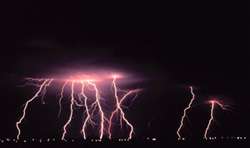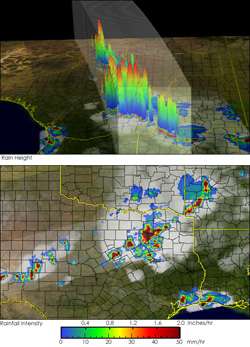NASA Satellite Identifies the World's Most Intense Thunderstorms

A summer thunderstorm often provides much-needed rainfall and heat wave relief, but others bring large hail, destructive winds, and tornadoes. Now with the help of NASA satellite data, scientists are gaining insight into the distribution of such storms around much of the world.
By using data from the NASA Tropical Rainfall Measuring Mission (TRMM) satellite, researchers identified the regions on Earth that experience the most intense thunderstorms. Their study was published in the August 2006 issue of the Bulletin of the American Meteorological Society. The strongest storms were found to occur east of the Andes Mountains in Argentina, where warm, humid air often collides with cooler, drier air, similar to storms that form east of the Rockies in the United States. Surprisingly, some semi-arid regions have powerful storms, including the southern fringes of the Sahara, northern Australia, and parts of the Indian subcontinent. In contrast, rainy areas such as western Amazonia and Southeast Asia experience frequent storms, but relatively few are severe. Northern Pakistan, Bangladesh, and parts of Central Africa also experience intense thunderstorms.
"TRMM has given us the ability to extend local knowledge about storms to a near-global reach," said lead author Edward Zipser, University of Utah, Salt Lake City. "In addition to containing the only precipitation radar in space, TRMM's other instruments provide a powerful overlap of data that is extremely useful for studying storms."

The researchers examined global thunderstorm data supplied by TRMM from 1998-2004. To determine an individual storm's intensity, they specifically examined the height of radar echoes, radiation temperature, and lightning flash rate, each measured by separate TRMM instruments.
The study also confirmed previous findings. For example, the locations of the heaviest rainfall on Earth -- usually in tropical oceans and along certain mountain slopes -- rarely coincide with the regions of most intense storms. They also found that the strongest storms tend to occur over land, rather than over oceans. The intense storms that do develop over oceans usually occur in areas near land that favor storm motion from land to ocean. Examples include tropical oceans west of Central America and West Africa, and subtropical oceans east of the southeastern United States, South America, Australia and Africa. Many regions of the world also have a seasonal preference for strong storms, including spring and summer for the south-central United States, June-August in the Sahel, and March-May over the Ganges Plain and Bangladesh.
Studying storms with satellite data began in the 1960s when researchers discovered that colder cloud top temperatures were linked to more intense storms. But later, scientists found that many storms of average intensity also reach very high altitudes, where colder temperatures are found. For a more accurate, quantitative description of a storm, radar, microwave, and lightning data are also needed to study a thunderstorm's inner structure.
"Prior to TRMM, we could only study individual storms that were captured by a ground-based radar or lightning network," said co-author Daniel Cecil, University of Alabama-Huntsville, Huntsville, Ala. "Those instruments are not available in many places and trying to find an interesting storm that was simultaneously observed by a satellite required remarkable luck, but TRMM has been supplying a variety of measurements from individual storms around the world for nearly nine years now."
The instruments on TRMM provide data and precision that other satellites cannot. Its precipitation radar is unique because it measures the properties of a storm with high vertical resolution, helping scientists to identify the stronger rising air currents, or updrafts, in a thunderstorm. TRMM also has a lightning sensor, which identifies both cloud-to-ground and in-cloud lightning, and its microwave imager gives detailed information on the ice content within a storm, also related to the speed of updrafts.
While each TRMM instrument measures different aspects of a storm, the researchers found that the data from each usually matched quite well, agreeing on the location and distribution of the strongest storms.
"The results from this study help to quantify the differences in the type and intensity of thunderstorms that occur in different climate regimes around the world," said Cecil. "The effects on the atmosphere of an intense, monstrous thunderstorm over Argentina or Oklahoma contrasts greatly with the effects from a more ordinary storm over the Amazon basin."
In the future, and as the dataset from TRMM continues to increase, these observations will be used to test whether computer models used for climate prediction and weather forecasting are accurately capturing the details of thunderstorms. If not, scientists will have the details necessary to build better, more realistic models that will aid meteorologists in providing more accurate forecasts.
The Tropical Rainfall Measuring Mission (TRMM) is a joint mission between NASA and the Japan Aerospace Exploration Agency (JAXA) and is designed to monitor and study tropical rainfall.
Source: by Mike Bettwy, Goddard Space Flight Center





















